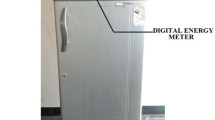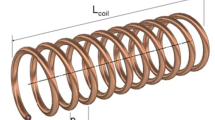Abstract
Capillary tube expansion devices are widely used in refrigeration equipment; nevertheless, the mechanism of the flow is still not fully described and understood, so the experimental verification of most predictions is still necessary. A modified numerical model of capillary flow has been developed both for standard refrigerants and with emphasis for saturated fluorocarbon (C2F2n+2) refrigerants. These refrigerants have several unique properties (high dielectric performance, chemical stability, and radiation resistance). Therefore, they can be used in some special applications, where other common fluids cannot be applied. The main aim of this study was to prepare a practical capillary flow model, which would improve the procedure of predicting the behavior of capillary tubes for cooling circuits of particle detectors being built at the international CERN laboratory in Geneva. The generated numerical model was verified through available data from the literature and also via measurements performed in a real cooling circuit with pure, oil-free octafluoropropane (C3F8) refrigerant.
Similar content being viewed by others
Abbreviations
- c p :
-
Specific heat (J · kg−1 · K−1)
- e :
-
Specific energy (e = h + v 2/2 = E + p/ρ) (J · kg−1)
- f :
-
Friction factor
- h :
-
Enthalpy (J · kg−1)
- \(\mathop m\limits^{\bullet}\) :
-
Mass flow rate (kg · s−1)
- p :
-
Pressure (Pa)
- q :
-
Heat flux (W · m−2)
- s :
-
Entropy (J · kg−1 · K−1)
- t :
-
Time (s)
- v :
-
Velocity (m · s−1)
- z :
-
Axial coordinate (m)
- A :
-
Capillary inner cross section (m2)
- E :
-
Energy (sum of internal energy and kinetic energy) (J · kg−1)
- ID :
-
Inner diameter (m)
- K z :
-
Body forces (gravity) (m · s−2)
- L :
-
Capillary tube length (m)
- P :
-
Capillary inner perimeter (m)
- Re :
-
Reynolds number
- S :
-
Slip ratio
- T :
-
Temperature (K)
- α :
-
Void fraction
- δ :
-
Capillary wall roughness (m)
- ρ :
-
Density (kg · m−3)
- τ :
-
Shear stress (Pa)
- x :
-
Vapor quality
- Δz :
-
Control volume length (m)
- ΦLO :
-
Two-phase multiplier
- amb:
-
Ambient
- crit:
-
Critical flow conditions
- dis:
-
Discharge—conditions at capillary outlet
- evap:
-
Evaporation
- i :
-
Control volume inlet (point i of the computational grid)
- i + 1:
-
Control volume outlet (point i + 1 of the computational grid)
- in:
-
Capillary inlet
- sat:
-
Saturation properties
- TP:
-
Two-phase
- w:
-
Condition at the capillary inner wall
- g:
-
Vapor phase
- l:
-
Liquid phase
- –:
-
Arithmetical average over a control volume
- ~:
-
Integral average over a control volume
References
Mikol E.P. (1963) J. ASHRAE 75–86
Li R.Y., Lin S., Chen Z.Y., Chen Z.H. (1990) Int. J. Refrig. 13, 181
Chen Z.H., Li R.Y., Lin S., Chen Z.Y. (1990) ASHRAE Trans. 96, 550
Lackme C. (1979) Int. J. Multiphase Flow 5, 131
Koizumi H., Yokoyama K. (1980) ASHRAE Trans. 86, 19
Bansal P.K., Rupasinghe A.S. (1998) Appl. Therm. Eng. 18, 207
Kritsadathikarn P., Songnetichaovalit T., Lokathada N. (2002) Res. Article, Sci. Asia 28, 71
Sami S.M., Tribes C. (1998) Appl. Therm. Eng. 18, 491
Wong T.N., Ooi K.T. (1996) Appl. Therm. Eng. 16, 625
Z.L. Miropolskiy, R.I. Shneyerova, A.I. Karamysheva, in International Heat Transfer Conference, vol. 5 (Paris, 1970), Paper B 4.7
Lin S., Kwok C.C.K., Li R.Y., Chen Z.H., Chen Z.Y. (1991) Int. J. Multiphase Flow 17, 95
Wongwises S., Chan P. (2000) Int. Comm. Heat Transfer 27, 343
Bansal P.K., Wang G. (2004) Appl. Therm. Eng. 24, 851
Sinpiboon J., Wongwises S. (2002) Appl. Therm. Eng. 22, 2015
Escanes F., Pérez-Segarra C.D., Oliva A. (1995) Int. J. Refrig. 18, 113
Gnielinski V. (1976) Int. Chem. Eng. 16, 359
García-Valladares O., Pérez-Segarra C.D., Oliva A. (2002) Appl. Therm. Eng. 22, 173
Xu B., Bansal P.K. (2002) Appl. Therm. Eng. 22, 1801
Yilmaz T., Ünal S. (1996) ASME J. Fluids Eng. 118, 150
Zhang C., Ding G. (2004) Int. J. Refrig. 27, 17
Melo C., Ferreira R.T.S., Boabaid Neto C., Concalves J.M. (1999) Appl. Therm. Eng. 19, 669
M.O. McLinden, S.A. Klein, E.W. Lemmon, A.P. Peskin, REFPROP Version 6.0 (National Institute of Standards and Technology, Gaithersburg, Maryland, 2000)
Vacek V., Hallewell G., Lindsay S. (2001) Fluid Phase Equilib. 185, 305
Vacek V., Hallewell G., Ilie S., Lindsay S. (2000) Fluid Phase Equilib. 174, 191
S.D. Chang, S.T. Ro, in 1996 International Refrigeration Conference, vol. 83 (Purdue Univ., Lafayette, Indiana, 1996)
Author information
Authors and Affiliations
Corresponding author
Rights and permissions
About this article
Cite this article
Vacek, V., Vinš, V. A Study of the Flow through Capillary Tubes Tuned for a Cooling Circuit with Saturated Fluorocarbon Refrigerants. Int J Thermophys 28, 1490–1508 (2007). https://doi.org/10.1007/s10765-007-0294-8
Published:
Issue Date:
DOI: https://doi.org/10.1007/s10765-007-0294-8




